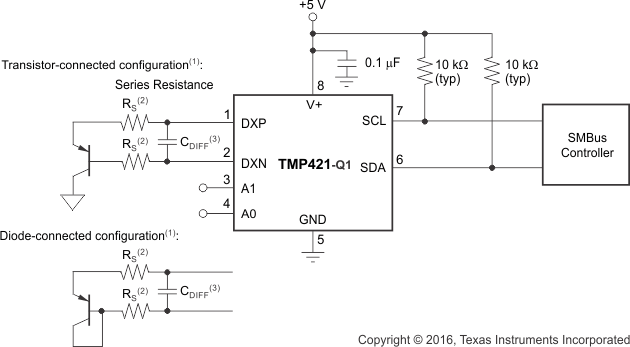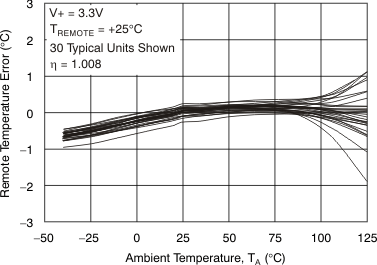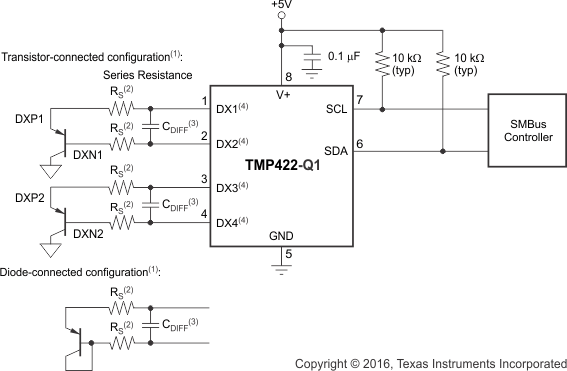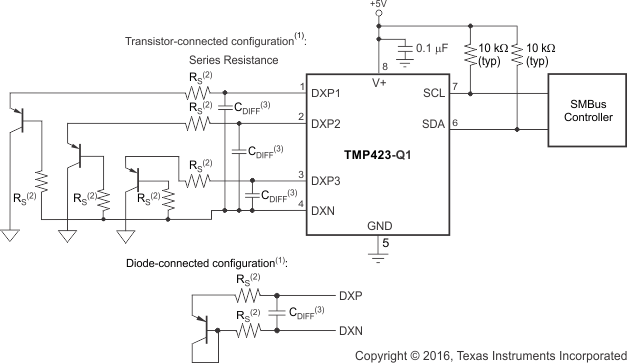SBOS821 November 2016 TMP421-Q1 , TMP422-Q1 , TMP423-Q1
PRODUCTION DATA.
- 1 Features
- 2 Applications
- 3 Description
- 4 Revision History
- 5 Device Comparison Table
- 6 Pin Configuration and Functions
- 7 Specifications
-
8 Detailed Description
- 8.1 Overview
- 8.2 Functional Block Diagram
- 8.3 Feature Description
- 8.4 Device Functional Modes
- 8.5
Programming
- 8.5.1 Serial Interface
- 8.5.2 Bus Overview
- 8.5.3 Bus Definitions
- 8.5.4 Serial Bus Address
- 8.5.5 Two-Wire Interface Slave Device Addresses
- 8.5.6 Read and Write Operations
- 8.5.7 High-Speed Mode
- 8.5.8 One-Shot Conversion
- 8.5.9 η-Factor Correction Register
- 8.5.10 Software Reset
- 8.5.11 General Call Reset
- 8.5.12 Identification Registers
- 8.6 Register Maps
- 9 Application and Implementation
- 10Power Supply Recommendations
- 11Layout
- 12Device and Documentation Support
- 13Mechanical, Packaging, and Orderable Information
Package Options
Mechanical Data (Package|Pins)
- DCN|8
Thermal pad, mechanical data (Package|Pins)
- DCN|8
Orderable Information
9 Application and Implementation
NOTE
Information in the following applications sections is not part of the TI component specification, and TI does not warrant its accuracy or completeness. TI’s customers are responsible for determining suitability of components for their purposes. Customers should validate and test their design implementation to confirm system functionality.
9.1 Application Information
The TMP42x-Q1 require a transistor connected between the DXP and DXN pins for remote temperature measurement. The SDA (and SCL if driven by an open-drain output) require pulllup resistors as part of the communication bus. The TMP421-Q1 includes slave address select pins (A1 and A0) allowing more than one device to reside on the same bus.
9.2 Typical Applications
9.2.1 TMP421-Q1 Basic Connections
The TMP421-Q1, TMP422-Q1, and TMP423-Q1 SCL and SDA interface pins each require pull-up resistors as part of the communication bus. A 0.1-μF power-supply bypass capacitor is recommended for local bypassing. Figure 20, Figure 21, and Figure 22 illustrate typical configurations for the TMP421-Q1, TMP422-Q1, and TMP423-Q1, respectively.

cancellation.
Figure 7, Remote Temperature Error vs Differential Capacitance.
9.2.1.1 Design Requirements
The TMP421-Q1, TMP422-Q1, and TMP423-Q1 are designed to be used with either discrete transistors or substrate transistors built into processor chips, field programmable gate arrays (FPGAs) and application-specific integrated circuits (ASICs). Either NPN or PNP transistors can be used, as long as the base-emitter junction is used as the remote temperature sense. NPN transistors must be diode-connected. PNP transistors can either be transistor or diode-connected.
Errors in remote temperature sensor readings are typically the consequence of the ideality factor and current excitation used by the TMP421-Q1, TMP422-Q1, and TMP423-Q1 versus the manufacturer-specified operating current for a given transistor. Some manufacturers specify a high-level and low-level current for the temperature-sensing substrate transistors. The TMP421-Q1, TMP422-Q1, and TMP423-Q1 use 6 μA for ILOW and 120 μA for IHIGH.
The ideality factor (η-factor) is a measured characteristic of a remote temperature sensor diode as compared to an ideal diode. The TMP421-Q1, TMP422-Q1, and TMP423-Q1 allow for different η-factor values; see the η-Factor Correction Register section.
The ideality factor for the TMP421-Q1, TMP422-Q1, and TMP423-Q1 is trimmed to be 1.008. For transistors that have an ideality factor that does not match the TMP421-Q1, TMP422-Q1, and TMP423-Q1, Equation 4 can be used to calculate the temperature error. Note that for the equation to be used correctly, actual temperature (°C) must be converted to kelvins (K).

where
- η = ideality factor of remote temperature sensor
- T(°C) = actual temperature
- TERR = error in TMP421-Q1, TMP422-Q1, and TMP423-Q1 because η ≠ 1.008
- Degree delta is the same for °C and K
For η = 1.004 and T (°C) = 100°C:

If a discrete transistor is used as the remote temperature sensor with the TMP421-Q1, TMP422-Q1, and TMP423-Q1, the best accuracy can be achieved by selecting the transistor according to the following criteria:
- Base-emitter voltage > 0.25 V at 6 μA, at the highest sensed temperature.
- Base-emitter voltage < 0.95 V at 120 μA, at the lowest sensed temperature.
- Base resistance < 100 Ω.
- Tight control of VBE characteristics indicated by small variations in hFE (that is, 50 to 150).
Based on these criteria, two recommended small-signal transistors are the 2N3904 (NPN) or 2N3906 (PNP).
9.2.1.2 Detailed Design Procedure
The local temperature sensor inside the TMP421-Q1, TMP422-Q1, and TMP423-Q1 is influenced by the ambient air around the device but mainly monitors the PCB temperature that it is mounted to. In most applications, the TMP421-Q1, TMP422-Q1, and TMP423-Q1 package is in electrical, and therefore thermal, contact with the printed-circuit board (PCB), as well as subjected to forced airflow. The accuracy of the measured temperature directly depends on how accurately the PCB and forced airflow temperatures represent the temperature that the TMP421-Q1, TMP422-Q1, and TMP423-Q1 is measuring. Additionally, the internal power dissipation of the TMP421-Q1, TMP422-Q1, and TMP423-Q1 can cause the temperature to rise above the ambient or PCB temperature. The internal power is negligible because of the small current drawn by TMP421-Q1, TMP422-Q1, and TMP423-Q1 (see the Measurement Accuracy and Thermal Considerations section for more details).
For this design example a diode connected 2N3906 transistor was used thus the default setting of the n-factor and offset can be used.
9.2.1.3 Application Curve
The following curve shows the typical accuracy of the TMP421-Q1, TMP422-Q1, and TMP423-Q1 when connected to a 2N3906 remote transistor. All three TMP421-Q1, TMP422-Q1, and TMP423-Q1 will have the same performance and have identical design requirements when it comes to the accuracy of the remote sensor.

9.2.2 TMP422-Q1 Basic Connections

cancellation.
Figure 7, Remote Temperature Error vs Differential Capacitance.
9.2.3 TMP423-Q1 Basic Connections

cancellation.
Figure 7, Remote Temperature Error vs Differential Capacitance.